Items filtered by date: December 2024
What Is Toenail Fungus?
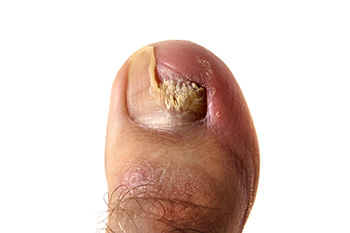
Toenail fungus causes toenails to become discolored, thickened, and brittle. People most likely to develop toenail fungus include those with medical conditions like diabetes, poor circulation, or a weakened immune system. Smoking can also increase the risk, as it damages blood vessels and reduces circulation to the feet. Additionally, older adults are more susceptible, as aging can lead to reduced nail growth and changes in skin structure, making it easier for fungi to invade. Toenail fungus is caused by dermatophytes, yeasts, or molds that thrive in warm, damp environments like public showers or tight, sweaty shoes. Symptoms include yellow, brittle, or distorted nails and there may be an unpleasant odor. Persistent or severe infections may require prescription antifungal medication or laser treatment. A podiatrist can provide a proper diagnosis and develop an effective treatment plan to ensure the infection is fully treated. If you suspect toenail fungus, it is suggested that you schedule an appointment with a podiatrist.
For more information about treatment, contact Mark Poplawski, DPM of Jersey Shore Podiatry, LLC. Our doctor can provide the care you need to keep you pain-free and on your feet.
Toenail Fungus Treatment
Toenail fungus is a condition that affects many people and can be especially hard to get rid of. Fortunately, there are several methods to go about treating and avoiding it.
Antifungals & Deterrence
Oral antifungal medicine has been shown to be effective in many cases. It is important to consult with a podiatrist to determine the proper regiment for you, or potentially explore other options.
Applying foot powder on the feet and shoes helps keep the feet free of moisture and sweat.
Sandals or open toed shoes – Wearing these will allow air movement and help keep feet dry. They also expose your feet to light, which fungus cannot tolerate. Socks with moisture wicking material also help as well.
If you have any questions please contact our office located in Toms River, NJ . We offer the newest diagnostic and treatment technologies for all your foot and ankle needs.
The Benefits of Cycling for Ankle Injury Recovery
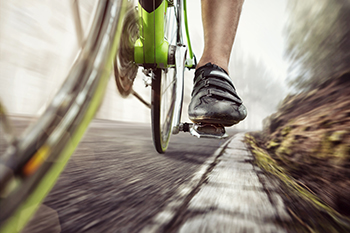
Cycling is an excellent low-impact exercise that can aid in the recovery of an ankle injury. It helps to strengthen the muscles surrounding the ankle without putting excessive strain on the joint, allowing for a safe recovery process. The circular motion of pedaling promotes improved blood circulation, which helps reduce swelling and supports the healing process. Cycling also enhances ankle joint flexibility and range of motion, as the consistent movement gently stretches the tendons and ligaments. This can prevent stiffness and promote quicker recovery. Additionally, cycling allows for cardiovascular exercise without the high-impact stress that activities like running or jumping can place on an injured ankle. By incorporating cycling into rehabilitation, individuals can regain strength and mobility. If you have injured your ankle, it is suggested that you visit a podiatrist who can offer effective treatment strategies.
Sports related foot and ankle injuries require proper treatment before players can go back to their regular routines. For more information, contact Mark Poplawski, DPM of Jersey Shore Podiatry, LLC. Our doctor can provide the care you need to keep you pain-free and on your feet.
Sports Related Foot and Ankle Injuries
Foot and ankle injuries are a common occurrence when it comes to athletes of any sport. While many athletes dismiss the initial aches and pains, the truth is that ignoring potential foot and ankle injuries can lead to serious problems. As athletes continue to place pressure and strain the area further, a mild injury can turn into something as serious as a rupture and may lead to a permanent disability. There are many factors that contribute to sports related foot and ankle injuries, which include failure to warm up properly, not providing support or wearing bad footwear. Common injuries and conditions athletes face, including:
- Plantar Fasciitis
- Achilles Tendinitis
- Achilles Tendon Rupture
- Ankle Sprains
Sports related injuries are commonly treated using the RICE method. This includes rest, applying ice to the injured area, compression and elevating the ankle. More serious sprains and injuries may require surgery, which could include arthroscopic and reconstructive surgery. Rehabilitation and therapy may also be required in order to get any recovering athlete to become fully functional again. Any unusual aches and pains an athlete sustains must be evaluated by a licensed, reputable medical professional.
If you have any questions please contact our office located in Toms River, NJ . We offer the newest diagnostic and treatment technologies for all your foot and ankle needs.
Why Live with Pain and Numbness in Your Feet?
Avoid Foot Pain From Standing All Day
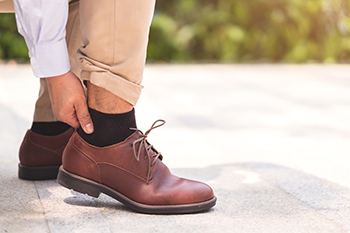
Standing on your feet all day can lead to foot pain, swelling, fatigue, and even more serious issues like plantar fasciitis, bunions, or varicose veins. Prolonged standing increases pressure on the feet causing discomfort and reducing circulation, which may result in aching muscles or stiffness. Over time it can also contribute to joint and ligament strain, impacting posture and overall health. To counteract these effects, wear supportive footwear with proper cushioning and arch support. Take short breaks to sit or stretch your legs whenever possible. Consider using anti-fatigue mats if standing in one spot for extended periods. Regularly stretching your calves, ankles, and feet can improve circulation and alleviate tension. If pain persists, it is suggested that you visit a podiatrist who can assess your feet, recommend orthotics or treatments, and help prevent long-term damage to your feet and overall health.
While working on the feet, it is important to take the proper care of them. For more information about working on your feet, contact Mark Poplawski, DPM from Jersey Shore Podiatry, LLC. Our doctor will treat your foot and ankle needs.
Working on Your Feet
Standing on your feet for long periods of time can cause stress and pain in your feet. Your whole body may experience change in terms of posture, back pain, bunions, callouses and or plantar warts. There are ways to avoid these conditions with proper foot care, smart choices and correct posture.
Positive Changes
Negative heeled shoe – Choosing this shoe type places the heel slightly lower than the ball of the foot. These are great for overall foot health. Find shoes that fit you correctly.
Go barefoot – Our feet were not designed to be enclosed for all hours of the day. Try to periodically expose your feet to air.
Eliminate Pain
Foot Exercises – Performing simple exercises, incorporating yoga and doing stretches are beneficial. This will allow increased blood flow to the area and muscles of the foot.
Achilles tendon – Stretching the foot out flat on the floor will relax the calf muscles and tendon. These exercises can be performed almost anywhere. Make sure you add these exercises to your daily regimen.
With a little bit of this information and knowing more about foot health, you will notice changes. Foot stretches and proper footwear will help with pain and prevent further issues.
If you have any questions please contact our office located in Toms River, NJ . We offer the newest diagnostic and treatment technologies for all your foot and ankle needs.
Foot Care Tips for Healthy Feet
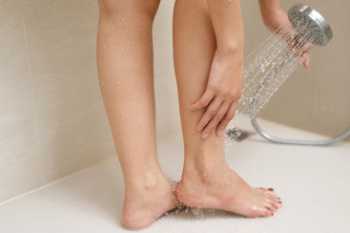
Proper foot care is essential for maintaining overall health and mobility. To keep your feet healthy, it is important to wash them regularly with mild soap and warm water, ensuring they are thoroughly dried to prevent fungal infections. Moisturizing the feet helps keep the skin soft and prevents dryness or cracking, particularly on the heels. Wearing well-fitting shoes that provide adequate support is vital for avoiding blisters, calluses, and foot pain. Additionally, it is important to trim toenails properly to prevent ingrown nails and infections. Regularly inspect your feet for any signs of injury, infection, or abnormal changes, such as swelling or discoloration. Those with diabetes, need to take extra care of their feet as nerve damage can reduce sensitivity. If you have foot pain or a specific foot condition, it is suggested that you consult a podiatrist who can offer relief tips, and guide you on everyday foot care practices.
Everyday foot care is very important to prevent infection and other foot ailments. If you need your feet checked, contact Mark Poplawski, DPM from Jersey Shore Podiatry, LLC. Our doctor can provide the care you need to keep you pain-free and on your feet.
Everyday Foot Care
Often, people take care of their bodies, face and hair more so than they do for their feet. But the feet are a very important aspect of our bodies, and one that we should pay more attention to. Without our feet, we would not be able to perform most daily tasks.
It is best to check your feet regularly to make sure there are no new bruises or cuts that you may not have noticed before. For dry feet, moisturizer can easily be a remedy and can be applied as often as necessary to the affected areas. Wearing shoes that fit well can also help you maintain good foot health, as well as making it easier to walk and do daily activities without the stress or pain of ill-fitting shoes, high heels, or even flip flops. Wearing clean socks with closed shoes is important to ensure that sweat and bacteria do not accumulate within the shoe. Clean socks help to prevent Athlete’s foot, fungi problems, bad odors, and can absorb sweat.
If you have any questions, please feel free to contact our office located in Toms River, NJ . We offer the newest diagnostic and treatment technologies for all your foot care needs.
Managing Heel Spurs
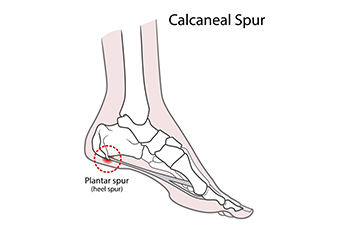
Bone spurs are bony growths that form along the edges of foot bones, often in areas where joints and ligaments meet. Heel spurs are a common type of bone spur, often causing pain and discomfort. They typically develop due to repetitive stress, aging, or conditions like arthritis, plantar fasciitis, or obesity. Over time, heel spurs can cause discomfort, particularly when they irritate nearby tissues. Common symptoms of heel spurs include pain, swelling, and inflammation, particularly when walking or standing for long periods. In some cases, certain types of bone spurs may not cause any symptoms and may only be discovered during an X-ray for another condition. Treatment for heel spurs may involve conservative measures like rest, anti-inflammatory medications, and custom orthotics to relieve pressure. In severe cases, targeted exercises or surgery may be necessary to remove the spur and restore function. A podiatrist can evaluate your condition, recommend appropriate treatments, and help manage pain. If you are experiencing foot pain or suspect a heel spur, it is suggested that you schedule an appointment with a podiatrist for a proper diagnosis and care plan.
Heel spurs can be incredibly painful and sometimes may make you unable to participate in physical activities. To get medical care for your heel spurs, contact Mark Poplawski, DPM from Jersey Shore Podiatry, LLC. Our doctor will do everything possible to treat your condition.
Heels Spurs
Heel spurs are formed by calcium deposits on the back of the foot where the heel is. This can also be caused by small fragments of bone breaking off one section of the foot, attaching onto the back of the foot. Heel spurs can also be bone growth on the back of the foot and may grow in the direction of the arch of the foot.
Older individuals usually suffer from heel spurs and pain sometimes intensifies with age. One of the main condition's spurs are related to is plantar fasciitis.
Pain
The pain associated with spurs is often because of weight placed on the feet. When someone is walking, their entire weight is concentrated on the feet. Bone spurs then have the tendency to affect other bones and tissues around the foot. As the pain continues, the feet will become tender and sensitive over time.
Treatments
There are many ways to treat heel spurs. If one is suffering from heel spurs in conjunction with pain, there are several methods for healing. Medication, surgery, and herbal care are some options.
If you have any questions, please feel free to contact our office located in Toms River, NJ . We offer the newest diagnostic and treatment technologies for all your foot care needs.





